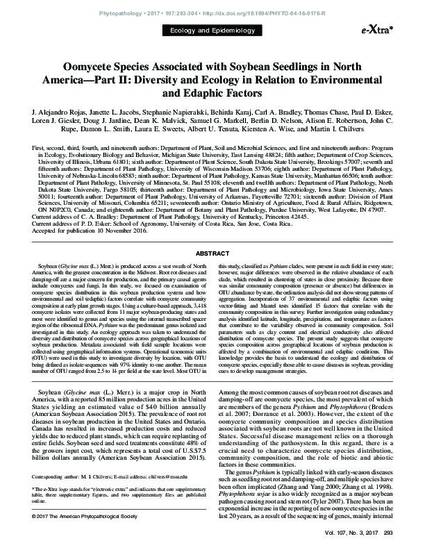
Soybean (Glycine max (L.) Merr.) is produced across a vast swath of North America, with the greatest concentration in the Midwest. Root rot diseases and damping-off are a major concern for production, and the primary causal agents include oomycetes and fungi. In this study, we focused on examination of oomycete species distribution in this soybean production system and how environmental and soil (edaphic) factors correlate with oomycete community composition at early plant growth stages. Using a culture-based approach, 3,418 oomycete isolates were collected from 11 major soybean-producing states and most were identified to genus and species using the internal transcribed spacer region of the ribosomal DNA. Pythium was the predominant genus isolated and investigated in this study. An ecology approach was taken to understand the diversity and distribution of oomycete species across geographical locations of soybean production. Metadata associated with field sample locations were collected using geographical information systems. Operational taxonomic units (OTU) were used in this study to investigate diversity by location, with OTU being defined as isolate sequences with 97% identity to one another. The mean number of OTU ranged from 2.5 to 14 per field at the state level. Most OTU in this study, classified as Pythium clades, were present in each field in every state; however, major differences were observed in the relative abundance of each clade, which resulted in clustering of states in close proximity. Because there was similar community composition (presence or absence) but differences in OTU abundance by state, the ordination analysis did not show strong patterns of aggregation. Incorporation of 37 environmental and edaphic factors using vector-fitting and Mantel tests identified 15 factors that correlate with the community composition in this survey. Further investigation using redundancy analysis identified latitude, longitude, precipitation, and temperature as factors that contribute to the variability observed in community composition. Soil parameters such as clay content and electrical conductivity also affected distribution of oomycete species. The present study suggests that oomycete species composition across geographical locations of soybean production is affected by a combination of environmental and edaphic conditions. This knowledge provides the basis to understand the ecology and distribution of oomycete species, especially those able to cause diseases in soybean, providing cues to develop management strategies.
Available at: http://works.bepress.com/alison-robertson/254/

This article is published as Rojas, J. Alejandro, Janette L. Jacobs, Stephanie Napieralski, Behirda Karaj, Carl A. Bradley, Thomas Chase, Paul D. Esker et al. "Oomycete species associated with soybean seedlings in North America—Part II: Diversity and ecology in relation to environmental and edaphic factors." Phytopathology 107, no. 3 (2017): 293-304. doi: 10.1094/PHYTO-04-16-0176-R. Posted with permission.